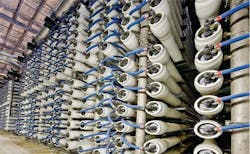Although the Chinese government is aiming to produce 3 million m3/day of water from desalination by 2020, this could come at a heavy environmental price, according to the World Resources Institute (WRI).
In an analysisof the water-energy nexus in Qingdao, WRI said desalination plants consume 4 kilowatt-hours per cubic metre (kWhs/m3), compared to wastewater reuse, which they said consumes less than 1 kWhs/m3.
WRI said that, as a result of coal being China’s dominant energy source, “consuming greater amounts of desalinated water would simultaneously increase greenhouse gas emissions”.
The Institute added that if all 400,000 cubic meters of Qingdao’s proposed daily desalination capacity were in place, greenhouse gas emissions would increase by 80% per cubic meter of water produced.
In fast-urbanizing China, nearly 90% of coastal cities face some degree of water scarcity and roughly 300 million rural residents lack access to clean water.
As a result, the Chinese government is aiming to produce as much as 3 million cubic meters of desalinated water daily by 2020, up from today’s 770,000 m3/day.
The cities of Qingdao and Tianjin – where per capita water availability is only 12% and 7% of the national average, respectively – have both commissioned desalination plants.
Qingdao’s desalination plant was constructed by the Spanish company, Abengoa, in 2010, and is said to produce 100,000 m3/day for 500,000 people (roughly 25% of Qingdao’s downtown population).
Tianjin is home to the Beijiang and Dagang desalination plants, which together are expected to account for a third of China’s 1.5-2 million-ton capacity by 2015.
Speaking to WWi as part of a feature on China’s South-North Water Transfer, Simon Spooner, consultant at Atkins Water & Environment International and honorary professor at Nottingham University Ningbo, China, said: “When you consider the energy requirement of desalination and the problems in supplying that energy, in terms of resource consumption and carbon emissions, then that’s really looking quite problematic. The whole Chinese desalination journey seems to be getting a bit shaky as well. Some of the plants that have already been built have got problems they are looking into.”
WRI concluded: “Until desalination technology becomes more energy efficient, it should only be used as a backup source of water in China.”
###
Read more
China’s South-North transfer “critical” to avoid a water crisis With the Central Route of China’s South-North Water Transfer (SNWT) project finished in October, experts have said that completion of the ambitious project is critical if the country is to carry on developing at its current rate…
Seawater desalination: a promise for China’s future? With China's State Council establishing a higher than expected target for desalination capacity by 2015, market activity has accelerated. Ahead of the IDA World Congress in Tianjin, Khoo Teng Chye looks at how international companies are tackling the rapidly moving Chinese market…
Membranes in China: Boom or Bust for International Manufacturers? A goal stipulating that 70% of all equipment used in desalination plants should be produced in China is perhaps more relevant to global suppliers.




